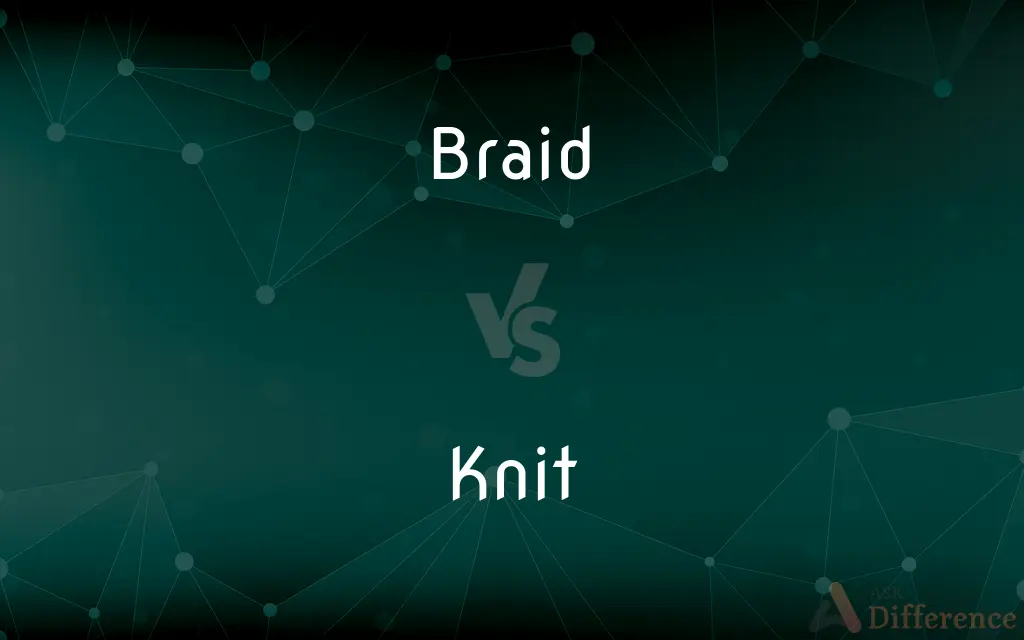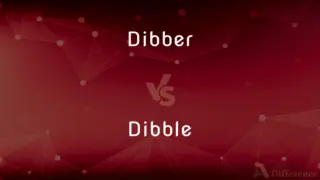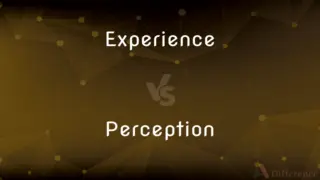Braid vs. Knit — What's the Difference?
By Tayyaba Rehman & Fiza Rafique — Updated on April 30, 2024
Braid involves intertwining three or more strands of material, while knitting is creating fabric by interlocking loops of yarn with needles.

Difference Between Braid and Knit
Table of Contents
ADVERTISEMENT
Key Differences
Braiding is a technique used to weave together three or more strands of flexible materials such as hair, wire, or textile fibers to create a cohesive structure. Whereas, knitting involves manipulating yarn or thread with needles to create a series of interconnected loops that form a fabric or textile.
In braiding, the materials are typically crossed over one another in a systematic pattern, creating a flat or tubular structure that is often strong and decorative. On the other hand, knitting primarily produces fabrics or garments and can vary in density and elasticity depending on the stitches used.
Braids can be quickly undone by simply unraveling the strands, assuming there are no knots. Whereas, unraveling knit fabric, commonly referred to as "frogging," involves undoing the loops, which can be a more intricate and time-consuming process.
The equipment required for braiding can be as minimal as just the strands being used, making it a more accessible activity. In contrast, knitting requires specific tools like knitting needles or a knitting machine, which can affect the portability and ease of the craft.
Braids are often used for functional purposes, such as creating rope or hairstyles that secure materials or hair out of the way. Knitting, while it can be decorative, is primarily valued for its ability to produce clothing and other textiles that provide warmth and coverage.
ADVERTISEMENT
Comparison Chart
Technique
Intertwining strands in a systematic pattern
Interlocking loops with needles
Result
Flat or tubular structure
Fabric or garments
Undoing Process
Easily unraveled
Requires unraveling loops (frogging)
Tools Required
Minimal, often just the strands
Requires needles or a machine
Primary Use
Decorative or functional (e.g., ropes)
Clothing and textiles for warmth and coverage
Compare with Definitions
Braid
An ornamental cord or band used in design or artwork.
He used a red braid as an accent on the white dress.
Knit
A type of stitch in knitting.
She used a purl stitch immediately after a knit stitch for the ribbing.
Braid
A narrow, decorative component of a garment resembling a woven structure.
The braid along the border of the ceremonial robes was golden.
Knit
A method of making fabric by interlocking yarn loops.
She learned to knit at a young age, making scarves and hats.
Braid
A complex pattern created by intertwining three or more strands of flexible material.
She admired the intricate braid in her daughter's hair.
Knit
The action or process of knitting fabric.
Knit involves a series of loop formations that can become quite complex.
Braid
A technique used for strengthening or decorating objects.
Braid is often applied in rope-making for its durability.
Knit
A fabric or textile resulting from knitting.
The sweater was made of a soft, blue knit.
Braid
A pattern resembling the intertwining of strands.
The braid pattern on the cake was made with icing.
Knit
An item of clothing made by knitting.
His favorite winter knit is a thick, woolen jumper.
Braid
A braid (also referred to as a plait) is a complex structure or pattern formed by interlacing two or more strands of flexible material such as textile yarns, wire, or hair. Braids have been made for thousands of years, in many different cultures around the world, for a variety of uses.
Knit
To make (a fabric or garment) by intertwining yarn or thread in a series of connected loops either by hand, with knitting needles, or on a machine.
Braid
Threads of silk, cotton, or other material woven into a decorative band for edging or trimming garments
Fancy braids
A coat trimmed with gold braid
Knit
To form (yarn or thread) into fabric by intertwining.
Braid
A length of hair made up of three or more interlaced strands
Her hair curled neatly in blonde braids
Knit
To join closely; unite securely.
Braid
Interlace three or more strands of (hair or other flexible material) to form a length
Their long hair was tightly braided
Knit
To draw (the brows) together in wrinkles; furrow.
Braid
Edge or trim (a garment) with braid
Braided red trousers
Knit
To make a fabric or garment by knitting.
Braid
(of a river or stream) flow into shallow interconnected channels divided by deposited earth or alluvium
A braided river carries an enormous burden of sand and gravel
Knit
To become securely joined or mended together closely, as a fractured bone.
Braid
To interweave three or more strands, strips, or lengths of in a diagonally overlapping pattern
Braided the rags into a strong rope.
Knit
To come together in wrinkles or furrows, as the brows.
Braid
To create (something) by such interweaving
Braid a rug.
Knit
A fabric or garment made by knitting.
Braid
To style (the hair) by such interweaving.
Knit
The way in which a fabric has been knit
A loose knit.
Braid
To mingle (discrete elements, for example) as if by such interweaving
Braided the ideas into a complex thesis.
Knit
(ambitransitive) To turn thread or yarn into a piece of fabric by forming loops that are pulled through each other. This can be done by hand with needles or by machine.
To knit a stocking
The first generation knitted to order; the second still knits for its own use; the next leaves knitting to industrial manufacturers.
Braid
To decorate or edge (something) with a trim of interwoven strands
Finished the jacket by braiding the collar and cuffs.
Knit
To join closely and firmly together.
The fight for survival knitted the men closely together.
Braid
To fasten or decorate (hair) with a band or ribbon.
Knit
(intransitive) To become closely and firmly joined; become compacted.
Braid
To flow, twist, or wind as if interwoven
A stream braiding through the woods.
Knit
(intransitive) To grow together.
All those seedlings knitted into a kaleidoscopic border.
Braid
A braided segment or length, as of hair, fabric, or fiber.
Knit
(transitive) To combine from various elements.
The witness knitted together his testimony from contradictory pieces of hearsay.
Braid
Ornamental cord or ribbon, used especially for decorating or edging fabrics.
Knit
To heal following a fracture.
I’ll go skiing again after my bones knit.
Braid
A ribbon or band used to fasten the hair.
Knit
(transitive) To form into a knot, or into knots; to tie together, as cord; to fasten by tying.
Braid
To make a sudden movement with, to jerk.
Knit
(transitive) To draw together; to contract into wrinkles.
Braid
To start into motion.
Knit
A knitted garment.
Braid
(transitive) To weave together, intertwine (strands of fibers, ribbons, etc.); to arrange (hair) in braids.
Knit
A session of knitting.
Braid
To mix, or make uniformly soft, by beating, rubbing, or straining, as in preparing food.
Knit
To form into a knot, or into knots; to tie together, as cord; to fasten by tying.
A great sheet knit at the four corners.
When your head did but ache,I knit my handkercher about your brows.
Braid
(obsolete) To reproach; to upbraid.
Knit
To form, as a textile fabric, by the interlacing of yarn or thread in a series of connected loops, by means of needles, either by hand or by machinery; as, to knit stockings.
Braid
(obsolete) A sudden movement; a jerk, a wrench.
Knit
To join; to cause to grow together.
Nature can not knit the bones while the parts are under a discharge.
Braid
A weave of three or more strands of fibers, ribbons, cords or hair often for decoration.
Knit
To unite closely; to connect; to engage; as, hearts knit together in love.
Thy merit hath my duty strongly knit.
Come, knit hands, and beat the ground,In a light fantastic round.
A link among the days, toknitThe generations each to each.
Braid
A stranded wire composed of a number of smaller wires twisted together
Knit
To draw together; to contract into wrinkles.
He knits his brow and shows an angry eye.
Braid
A tubular sheath made of braided strands of metal placed around a central cable for shielding against electromagnetic interference.
Knit
To form a fabric by interlacing yarn or thread; to weave by making knots or loops.
Braid
(obsolete) A caprice or outburst of passion or anger.
Knit
To be united closely; to grow together; as, broken bones will in time knit and become sound.
Braid
To weave, interlace, or entwine together, as three or more strands or threads; to form into a braid; to plait.
Braid your locks with rosy twine.
Knit
Union knitting; texture.
Braid
To mingle, or to bring to a uniformly soft consistence, by beating, rubbing, or straining, as in some culinary operations.
Knit
A fabric made by knitting
Braid
To reproach. [Obs.] See Upbraid.
Knit
A basic knitting stitch
Braid
To start; to awake.
Knit
Needlework created by interlacing yarn in a series of connected loops using straight eyeless needles or by machine
Braid
A plait, band, or narrow fabric formed by intertwining or weaving together different strands.
A braid of hair composed of two different colors twined together.
Knit
Make (textiles) by knitting;
Knit a scarf
Braid
A narrow fabric, as of wool, silk, or linen, used for binding, trimming, or ornamenting dresses, etc.
Knit
Tie or link together
Braid
A quick motion; a start.
Knit
To gather something into small wrinkles or folds;
She puckered her lips
Braid
A fancy; freak; caprice.
Braid
Deceitful.
Since Frenchmen are so braid,Marry that will, I live and die a maid.
Braid
A hairdo formed by braiding or twisting the hair
Braid
Trimming used to decorate clothes or curtains
Braid
Make by braiding or interlacing;
Lace a tablecloth
Braid
Decorate with braids or ribbons;
Braid a collar
Braid
Form or weave into a braid or braids;
Braid hair
Common Curiosities
Can braiding create fabric like knitting does?
No, braiding typically creates more structured and less flexible products compared to the fabric produced by knitting.
Is knitting more versatile than braiding?
Yes, knitting can produce a variety of densities and elasticities, making it suitable for different types of garments and textiles.
Do both braiding and knitting require special tools?
Braiding can often be done with just the strands themselves, while knitting requires needles or a machine.
Can both braiding and knitting be decorative?
Yes, both techniques are used decoratively, but braiding is often seen in smaller scale projects like hair or garment trims, while knitting is used for larger items like sweaters and blankets.
Which is quicker to undo, a braid or knit?
A braid is generally quicker to undo as it involves simply unraveling the strands without dealing with interlocked loops.
Which technique is older, braiding or knitting?
Braiding is one of the oldest crafting techniques, predating knitting by centuries.
Can you combine braiding and knitting in a single project?
Yes, it's possible to incorporate braiding into knitted projects for decorative purposes or structural reinforcement.
What is a common use of braiding?
Braiding is commonly used in hairstyles and for making strong, durable ropes.
What is a common use of knitting?
Knitting is primarily used for creating clothing and textiles that are warm and soft.
What is the main difference between braiding and knitting?
Braiding involves intertwining strands, while knitting involves creating loops with needles.
Which craft is more accessible to beginners?
Braiding tends to be more accessible and easier to start learning with minimal equipment.
Are there cultural significances associated with braiding and knitting?
Both crafts have rich cultural significances; braiding is often seen in traditional crafts and ceremonies, while knitting has a storied history in clothing and resistance movements.
What materials can you use for braiding and knitting?
Braiding can be done with any flexible strands, like hair or fibers, while knitting is usually done with yarn or thread.
Can braiding and knitting both be automated?
Knitting can be fully automated with machines, whereas braiding is less commonly automated and often done by hand.
How do environmental conditions affect braiding and knitting?
Braiding is less sensitive to environmental conditions, while knitting can be affected by humidity and yarn tension.
Share Your Discovery

Previous Comparison
Dibber vs. Dibble
Next Comparison
Experience vs. PerceptionAuthor Spotlight
Written by
Tayyaba RehmanTayyaba Rehman is a distinguished writer, currently serving as a primary contributor to askdifference.com. As a researcher in semantics and etymology, Tayyaba's passion for the complexity of languages and their distinctions has found a perfect home on the platform. Tayyaba delves into the intricacies of language, distinguishing between commonly confused words and phrases, thereby providing clarity for readers worldwide.
Co-written by
Fiza RafiqueFiza Rafique is a skilled content writer at AskDifference.com, where she meticulously refines and enhances written pieces. Drawing from her vast editorial expertise, Fiza ensures clarity, accuracy, and precision in every article. Passionate about language, she continually seeks to elevate the quality of content for readers worldwide.
















































